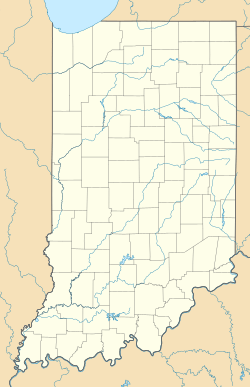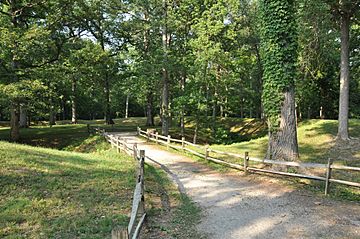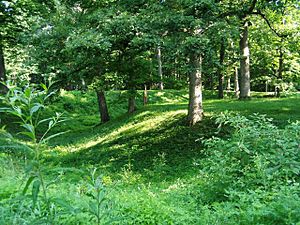Mounds State Park facts for kids

Mounds State Park entrance sign.
|
|
| Location | Anderson, Indiana, Madison County, Indiana, |
|---|---|
| Region | Madison County, Indiana |
| Coordinates | 40°6′1.39″N 85°37′14.60″W / 40.1003861°N 85.6207222°W |
| History | |
| Founded | 160 BCE |
| Cultures | Adena culture, Hopewell tradition |
| Site notes | |
| Architecture | |
| Architectural styles | earthworks |
| Architectural details | Number of monuments: 10 |
|
Mounds State Park
|
|
| Area | 251.8 acres (101.9 ha) |
| NRHP reference No. | 73000022 |
| Added to NRHP | January 18, 1973 |
| Responsible body: Indiana Department of Natural Resources | |
Mounds State Park is a state park near Anderson, Madison County, Indiana featuring Native American heritage, and ten ceremonial mounds built by the prehistoric Adena culture indigenous peoples of eastern North America, and also used centuries later by Hopewell culture inhabitants. It is separate from (and about 79 miles northwest of) the similarly named Mounds State Recreation Area (near Brookville, Franklin County, Indiana).
Contents
Mounds
The largest earthwork, the "Great Mound", is believed to have been constructed around 160 BCE. The Great Mound is a circular earth enclosure with an internal ditch and south to southwest entrance. The earthworks measure 394 feet (120.1 m) across from bank to bank. The 9-foot-tall (3 m) embankment is 63 feet (19 m) wide at its base, and the ditch is 10.5 feet (3.2 m) deep and 60 feet (18.3 m) across at its top. The central platform is 138 feet (42 m) across and was occupied by a 4-foot-high (1.2 m) central mound 30 feet (9 m) in diameter. One particular mound at the Anderson Site has a sequence of clay platforms, each deliberately covered by a layer of ash.
Earthworks
The term Earthworks includes any structure made from the earth. In Native American studies, there are three primary types: mounds, circular enclosures, and complexes. All are found in Central Indiana and in the state park. Mounds State Park has a complex of enclosures, both circular and rectangular. There are seven enclosures and four additional earthworks, which have been divided into two groups, the northern complex and the southern complex. The ‘’Great Mound" enclosure is the dominant structure in the park and the southern group.
Great Mound
The Great Mound is approximately 300 feet (91 m) across and consists of an outer embankment 9 feet (2.7 m) high and 63 feet (19 m) wide, surrounding a 60 feet (18 m) wide ditch that is 10.5 feet (3.2 m) deep. The central platform, 138 feet (42 m) is diameter with a central mound, 4 feet (1.2 m) high and 30 metres (98 ft) in diameter. The central mound was excavated in 1968/69 and found to have three clay layers, each with ashes, showing a succession of use periods.
The complex has been dated to 160 BCE through 50 CE These dates are obtained through radiocarbon dating and some artifacts. A nearby log tomb was found with a platform pipe typical of Hopewell styles from 50 C.E. Post hole remnants were dated to 60 BCE and 230 CE. Radiocarbon dates from excavated material of the Great Mound established 160 BCE +/- 90 for the embankment. The neighboring ‘’Fiddleback" Mound was dated to 120 BCE +/- 70.
Images for kids





